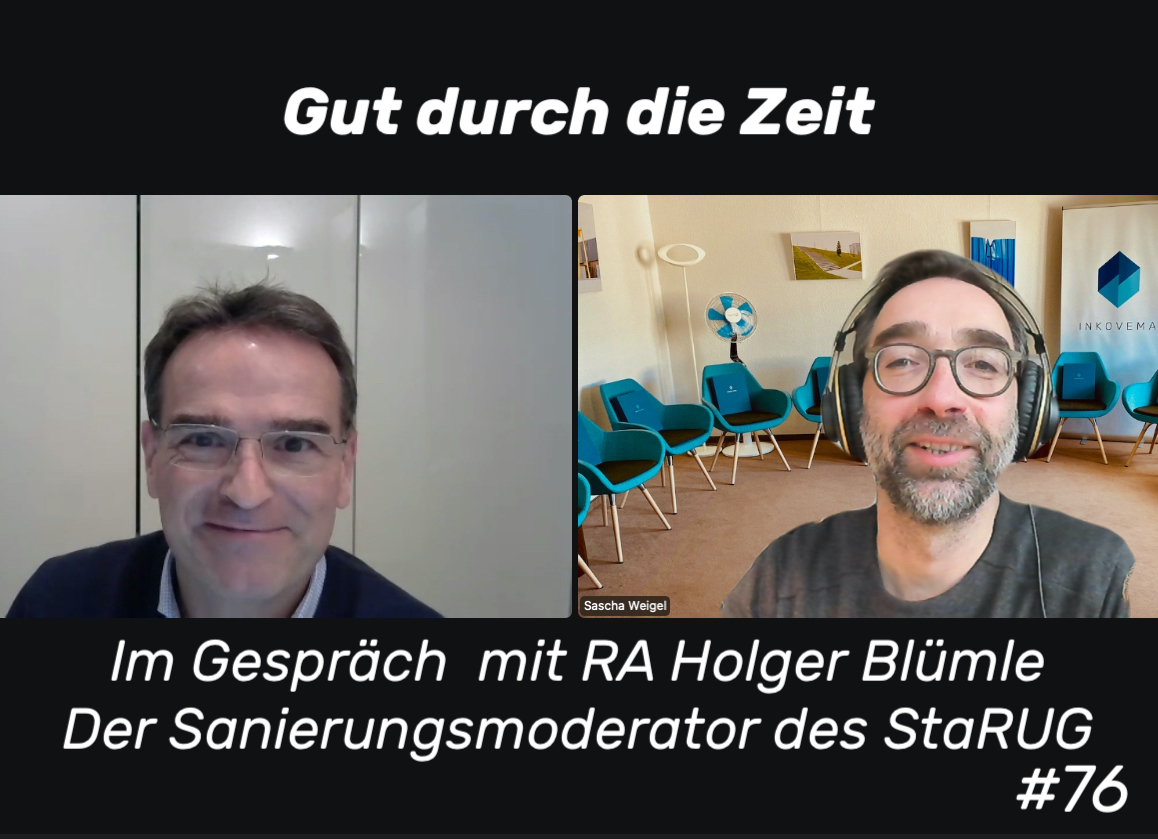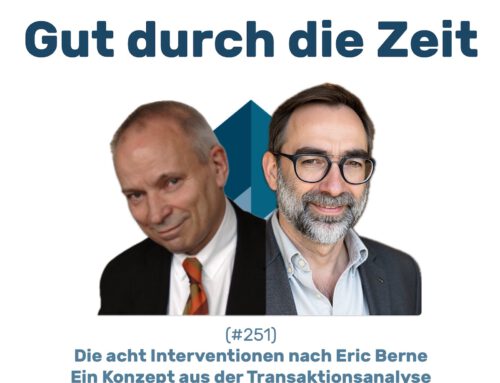INKOVEMA Podcast „Well through time“
#76 – The reorganisation moderator of the StaRUG
Proactive conflict management and moderation for companies in economic difficulties. In conversation with lawyer Holger Blümle from Schultze&Braun
Well through time. The podcast about mediation, conflict coaching and organisational consulting.
RA Holger Blümle, specialist lawyer for insolvency law at the renowned law firm Schultze&Braun, business economist (BA) and business mediator (IHK), specialising in self-administration, insolvency administration and insolvency plan proceedings.
1. introduction
This episode is about the Restructuring facilitation, a restructuring instrument of the 2021 Act on the Restructuring and Stabilisation Framework for Companies (StaRUG).
Restructuring moderation is in the pre-insolvency area, i.e. the company is not yet bankrupt, but it is foreseeable that this will happen if nothing happens and no concrete countermeasures are initiated now.
This is a preventative, proactive approach by the debtor. This goes hand in hand with a different entrepreneurial understanding and attribution of economic problems; the focus is no longer on debt, but on correction.
The reorganisation and restructuring process is carried out by the StaRUG in a formalised procedures outside of insolvency proceedings and represents a low-threshold Remodelling option However, this requires consensual solutions from the parties involved.
In contrast to insolvency proceedings, reorganisation moderation takes place on the debtor's initiative and only with those creditors that the debtor deems necessary after consultation with the reorganisation moderator.
2. localisation of the restructuring moderation
The following overview shows the location of the restructuring moderator in the tragedy of economic decline; although there is no insolvency yet, a clear financial imbalance will lead to this in the foreseeable future.
Common reorganisation options for restructuring companies in distress
- the "free" reorganisation outside the scope of the SraRUG,
- "quietly", e.g. without all creditors - external logistics, delivery services, suppliers, etc. - having to find out about the reorganisation,
- agreements and reorganisation measures that are not insolvency-proof or contestable,
- the reorganisation moderation according to §§ 94 ff StaRUG (our case here),
- almost "quietly", e.g. without all creditors having to find out about the reorganisation,
- insolvency-proof and contestable,
- the reorganisation moderation according to §§ 94 ff StaRUG using moratoria (enforcement freeze, realisation freeze) according to §§ 49 ff StaRUG,
- almost "quietly", not all creditors need to know about the reorganisation,
- insolvency-proof and contestable,
- restructuring under its own responsibility in accordance with the rules of the stabilisation and utilisation framework under Part 2 StaRUG,
- all creditors must be included in the reorganisation,
- insolvency-proof and contestable,
- judicial restructuring in accordance with the rules of the stabilisation and utilisation framework under Part 2 StarRUG,
- all creditors must be included in the reorganisation,
- insolvency-proof and contestable,
- the protective shield proceedings pursuant to section 270d InsO and
- the insolvency proceedings (standard insolvency proceedings, self-administration, both also as insolvency plan proceedings).
3. aim of the reorganisation moderation
Your goal is
- the amicable conclusion of a reorganisation settlement (not a reorganisation plan in accordance with §§ 2 ff. StaRUG.)
- between the creditors, the company at risk and other parties involved
- within 3 months
- to avert corporate insolvency.
- and thus a reorganisation comparisonwhich sets the creditor contributions in relation to each other!!! This would not be possible with a majority of simple, bilateral settlements between the debtor and his creditors.
4. labour and Tasks of the reorganisation moderator in the reorganisation moderation
- After being appointed by the court, the moderator inspects the company's books and business records.
- He also requests appropriate information from the debtor.
- The reorganisation moderator essentially mediates the interests of all parties involved in the reorganisation.
- Finally, a reorganisation settlement is to be concluded, §97 para.1. The reorganisation settlement requires the consent of all parties involved in the settlement. A qualified majority similar to, § 25 StaRUG, is not sufficient. In addition, the reorganisation settlement only has effect vis-à-vis the parties to the settlement; it has no effect vis-à-vis third parties.
- The reorganisation moderator reports to the court in writing on a monthly basis about the nature and causes of the economic or financial difficulties, the group of creditors and other parties involved in the negotiations, the subject of the negotiations, the goal and the expected progress of the negotiations.
- If the restructuring moderation fails, the more complex stabilisation and restructuring framework may have to be applied in accordance with §§ 2 ff StaRUG. In this case, it is possible that the company will change and the restructuring facilitator will be appointed as the restructuring officer, § 100 para. 2 StaRUG.
Left:
- Website from Schultze&Braun on attorney Holger Blümle.





Leave A Comment